The Impact of Aggressive Conditions on the Mechanical and Rheological Properties of Components Produced Using Additive Manufacturing
Highlights
- An investigation of the behavior of recycled polylactide (rPLA) and wood–polymer composite (WPC, PLA+MD) manufactured via FDM under long-term marine exposure.
- The resistance to seawater-induced aging is higher for rPLA compared with WPC.
- The degradation of the mechanical properties (tensile strength, Young’s modulus, impact strength) is correlated with a reduction in molecular weight.
- There were distinct degradation dynamics: the rPLA degradation rate slowed over time, while WPC degradation accelerated.
Abstract
1. Introduction
2. Materials and Methods
2.1. Research Material
2.2. Research Methods
- (a)
- determination of mechanical properties under static tension: tensile strength (Rm [MPa]) and Young’s modulus (Et [MPa]). Tests were conducted in accordance with the PN-EN ISO 527-1, 2, 4:2012 standard [32] on a multifunctional testing machine from Zwick Roell GmbH & Co. (Ulm, Germany) with the following parameters: tensile speed v = 50 mm/min, measured force range 10 kN.
- (b)
- Charpy impact strength (ak [kJ m−2]) of notched specimens. Tests were conducted in accordance with the PN-EN ISO 179:2001 standard [33] using an electronic Charpy impact tester from VEB Werkstoffprüfmaschine (Leipzig, Germany). A pendulum with a nominal energy of 7.5 J was used for the tests.
- (c)
3. Results and Discussion
4. Conclusions
- The observed degradation behavior of recycled polylactide (rPLA) and the wood–polymer composite (WPC) confirms that the rate and mechanism of polymer deterioration in marine environments are strongly dependent on the material’s molecular architecture and the nature of its constituents. Hydrolytic scission of ester bonds in rPLA occurs readily under marine exposure, while the presence of lignocellulosic fillers in WPC promotes additional biodegradation pathways associated with microbial and enzymatic activity.
- The correlation between the reduction in molecular weight and the decline in mechanical performance demonstrates that the macromolecular degradation of polymer chains directly translates into the loss of load-bearing capacity. Molecular weight (Mv) can therefore serve as a reliable quantitative indicator of structural integrity loss and a diagnostic parameter for assessing long-term material performance in marine conditions.
- Wood-based polymer composites exhibit a complex degradation profile resulting from the interplay of hydrolytic, microbial, and mechanical factors. Although the organic phase accelerates biodegradation, it also contributes to partial stabilization of the composite’s mechanical performance in the early exposure stages due to its ability to absorb and redistribute stresses.
- The findings emphasize that both recycled PLA and wood-reinforced PLA composites require further optimization to balance mechanical durability and environmental degradability. Material design strategies should focus on controlled hydrolysis kinetics, improved interfacial adhesion between polymer and filler, and the use of surface modifiers or coupling agents that limit water diffusion while maintaining biodegradability.
Author Contributions
Funding
Institutional Review Board Statement
Informed Consent Statement
Data Availability Statement
Conflicts of Interest
Abbreviations
| ABS | Acrylonitrile Butadiene Styrene |
| ak | Charpy impact strength |
| BD | No data (used in tables) |
| c | Polymer concentration in solvent |
| Et | Young’s modulus |
| FDM | Fused Deposition Modeling |
| ISO | International Organization for Standardization |
| J | Joule (unit of energy) |
| k | Degradation rate constant |
| K, α | Mark–Houwink constants |
| MD | Wood flour (component of PLA + MD composite) |
| Mn | Number-average molecular weight |
| Mv | Viscosity-average molecular weight |
| PETG | Polyethylene Terephthalate Glycol |
| PLA | Polylactic Acid |
| PN-EN | Polish Standard—European Norm |
| PP | Polypropylene |
| rPLA | Recycled Polylactide |
| Rm | Tensile strength |
| t | Flow time of polymer solution |
| t0 | Flow time of pure solvent |
| UV | Ultraviolet |
| WPC | Wood–polymer Composite |
| [η] | Intrinsic viscosity |
| ηformula | Relative viscosity |
| ηspec | Specific viscosity |
References
- Kyzioł, L. Analysis of the possibility of the use of composite materials for the construction of special ships. Autobusy Tech. Eksploat. Syst. Transp. 2017, 18, 846–850. [Google Scholar]
- Mouritz, A.P.; Gellert, E.; Burchill, P.; Challis, K. Review of Advanced Composite Structures for Naval Ships and Submarines. Compos. Struct. 2001, 53, 21–42. [Google Scholar] [CrossRef]
- Neşer, G. Polymer Based Composites in Marine Use: History and Future Trends. Procedia Eng. 2017, 194, 19–24. [Google Scholar] [CrossRef]
- Dhandapani, A.; Krishnasamy, S.; Thiagamani, S.M.K.; Periasamy, D.; Muthukumar, C.; Sundaresan, T.K.; Ali, S.; Kurniawan, R. Evolution, Prospects, and Predicaments of Polymers in Marine Applications: A Potential Successor to Traditional Materials. Recycling 2024, 9, 8. [Google Scholar] [CrossRef]
- Michalska-Pożoga, I.; Szczepanek, M. Analysis of Particles’ Size and Degree of Distribution of a Wooden Filler in Wood–Polymer Composites. Materials 2021, 14, 6251. [Google Scholar] [CrossRef] [PubMed]
- Ahmadifar, M.; Benfriha, K.; Shirinbayan, M.; Tcharkhtchi, A. Additive Manufacturing of Polymer-Based Composites Using Fused Filament Fabrication (FFF): A Review. Appl. Compos. Mater. 2021, 28, 1335–1380. [Google Scholar] [CrossRef]
- Cuan-Urquizo, E.; Barocio, E.; Tejada-Ortigoza, V.; Pipes, R.B.; Rodriguez, C.A.; Roman-Flores, A. Characterization of the Mechanical Properties of FFF Structures and Materials: A Review on the Experimental, Computational and Theoretical Approaches. Materials 2019, 12, 895. [Google Scholar] [CrossRef]
- Oztan, C.; Karkkainen, R.; Fittipaldi, M.; Nygren, G.; Roberson, L.; Lane, M.; Celik, E. Microstructure and Mechanical Properties of Three Dimensional-Printed Continuous Fiber Composites. J. Compos. Mater. 2019, 53, 271–280. [Google Scholar] [CrossRef]
- Zhong, W.; Li, F.; Zhang, Z.; Song, L.; Li, Z. Short Fiber Reinforced Composites for Fused Deposition Modeling. Mater. Sci. Eng. A 2001, 301, 125–130. [Google Scholar] [CrossRef]
- Ito, M.; Nagai, K. Degradation Issues of Polymer Materials Used in Railway Field. Polym. Degrad. Stab. 2008, 93, 1723–1735. [Google Scholar] [CrossRef]
- Jachowicz, T.; Sikora, R. Methods of Forecasting of the Changes of Polymeric Products Properties. Polimery 2006, 51, 177–185. [Google Scholar] [CrossRef]
- Nicholson, J.W. Chemia Polimerów; WNT: Warszawa, Poland, 1996. [Google Scholar]
- Żuchowska, D. Polimery Konstrukcyjne; WNT: Warszawa, Poland, 1995. [Google Scholar]
- PN-EN ISO 472:2002; Terminologia Tworzyw Sztucznych Starzenie. PKN: Warszawa, Poland, 2002.
- Szlezyngier, W. Tworzywa Sztuczne; Politechnika Rzeszowska: Rzeszów, Poland, 1996; Volume 2. [Google Scholar]
- Sobkow, D.; Czaja, K. Influence of Accelerated Ageing Conditions on the Process of Polyolefines Degradation. Polimery 2003, 48, 627–632. [Google Scholar] [CrossRef]
- Kuka, E.; Andersons, B.; Cirule, D.; Andersone, I.; Kajaks, J.; Militz, H.; Bicke, S. Weathering Properties of Wood-Plastic Composites Based on Heat-Treated Wood and Polypropylene. Compos. Part A Appl. Sci. Manuf. 2020, 139, 106102. [Google Scholar] [CrossRef]
- Catto, A.L.; Montagna, L.S.; Almeida, S.H.; Silveira, R.M.B.; Santana, R.M.C. Wood Plastic Composites Weathering: Effects of Compatibilization on Biodegradation in Soil and Fungal Decay. Int. Biodeterior. Biodegrad. 2016, 109, 11–22. [Google Scholar] [CrossRef]
- Butylina, S.; Hyvärinen, M.; Kärki, T. A Study of Surface Changes of Wood-Polypropylene Composites as the Result of Exterior Weathering. Polym. Degrad. Stab. 2012, 97, 337–345. [Google Scholar] [CrossRef]
- Pająk, J.; Nowak, B.; Łabużek, S. Biodegradation of Selected Synthetic Polymers. Probl. Ekol. 2009, 13, 154–159. [Google Scholar]
- Michalska-Pożoga, I. Warunki starzenia tworzyw polimerowych. In Zeszyty Naukowe Politechniki Rzeszowskiej. Chemia; Politechnika Rzeszowska: Rzeszów, Poland, 2009; Volume 20, pp. 99–102. [Google Scholar]
- Drogoń, A.; Pyda, M. Study on Physical Aging of Amorphous Polylactide by Differential Scanning Calorimetry. Polimery 2019, 64, 127–135. [Google Scholar] [CrossRef]
- Gewert, B.; Plassmann, M.M.; MacLeod, M. Pathways for Degradation of Plastic Polymers Floating in the Marine Environment. Environ. Sci. Process. Impacts 2015, 17, 1513–1521. [Google Scholar] [CrossRef]
- Bazli, M.; Heitzmann, M.; Villacorta Hernandez, B. Durability of Fibre-Reinforced Polymer-Wood Composite Members: An Overview. Compos. Struct. 2022, 295, 115827. [Google Scholar] [CrossRef]
- Lucas, N.; Bienaime, C.; Belloy, C.; Queneudec, M.; Silvestre, F.; Nava-Saucedo, J.-E. Polymer Biodegradation: Mechanisms and Estimation Techniques—A Review. Chemosphere 2008, 73, 429–442. [Google Scholar] [CrossRef] [PubMed]
- Drzyzga, O.; Prieto, A. Plastic Waste Management, a Matter for the ‘Community’. Microb. Biotechnol. 2019, 12, 66–68. [Google Scholar] [CrossRef]
- Emadian, S.M.; Onay, T.T.; Demirel, B. Biodegradation of Bioplastics in Natural Environments. Waste Manag. 2017, 59, 526–536. [Google Scholar] [CrossRef]
- Brebu, M. Environmental Degradation of Plastic Composites with Natural Fillers—A Review. Polymers 2020, 12, 166. [Google Scholar] [CrossRef]
- Bhagia, S.; Bornani, K.; Agrawal, R.; Satlewal, A.; Ďurkovič, J.; Lagaňa, R.; Bhagia, M.; Yoo, C.G.; Zhao, X.; Kunc, V.; et al. Critical Review of FDM 3D Printing of PLA Biocomposites Filled with Biomass Resources, Characterization, Biodegradability, Upcycling and Opportunities for Biorefineries. Appl. Mater. Today 2021, 24, 101078. [Google Scholar] [CrossRef]
- Shahrubudin, N.; Lee, T.C.; Ramlan, R. An Overview on 3D Printing Technology: Technological, Materials, and Applications. Procedia Manuf. 2019, 35, 1286–1296. [Google Scholar] [CrossRef]
- PN-EN ISO 1183:2019; Metody Oznaczania Gęstości Tworzyw Sztucznych Nieporowatych. PKN: Warszawa, Poland, 2019.
- PN-EN ISO 527-1,2, 4:2012; Tworzywa Sztuczne. Oznaczanie Właściwości Mechanicznych Przy Statycznym Rozciąganiu. PKN: Warszawa, Poland, 2012.
- PN-EN ISO 179:2001; Tworzywa Sztuczne. Oznaczanie Udarności Metodą Charpy’ego. PKN: Warszawa, Poland, 2001.
- Robert, S. Przetwórstwo Tworzyw Wielkocząsteczkowych; PWN: Warszawa, Poland, 1987. [Google Scholar]
- Bhattarai, S.; Kumar, V. Molecular Weight Determination by Chromatography and Viscometry: A Case Study Using Novel Polysaccharide of Eupatorium adenophorum L. Carbohydr. Res. 2025, 554, 109542. [Google Scholar] [CrossRef] [PubMed]
- Broniewski, T.; Kapko, J. Metody Badań i Ocena Właściwości Tworzyw Sztucznych; Wydanictow Naukowo-Techniczne: Warszawa, Poland, 1970. [Google Scholar]
- Agustin-Salazar, S.; Cerruti, P.; Medina-Juárez, L.Á.; Scarinzi, G.; Malinconico, M.; Soto-Valdez, H.; Gamez-Meza, N. Lignin and Holocellulose from Pecan Nutshell as Reinforcing Fillers in Poly (Lactic Acid) Biocomposites. Int. J. Biol. Macromol. 2018, 115, 727–736. [Google Scholar] [CrossRef]
- Tokiwa, Y.; Calabia, B.P. Biodegradability and Biodegradation of Poly(Lactide). Appl. Microbiol. Biotechnol. 2006, 72, 244–251. [Google Scholar] [CrossRef] [PubMed]
- Schirp, A.; Ibach, R.; Pendleton, D.; Wolcott, M. Biological degradation of wood-plastic composites (WPC) and strategies for improving the resistance of WPC against biological decay. In Development of Commercial Wood Preservatives: Efficacy, Environmental, and Health Issues; ACS Symposium Series; Oxford University Press: Washington, DC, USA; American Chemical Society: New York, NY, USA, 2008; pp. 480–507. ISBN 0-8412-3951-7. [Google Scholar]
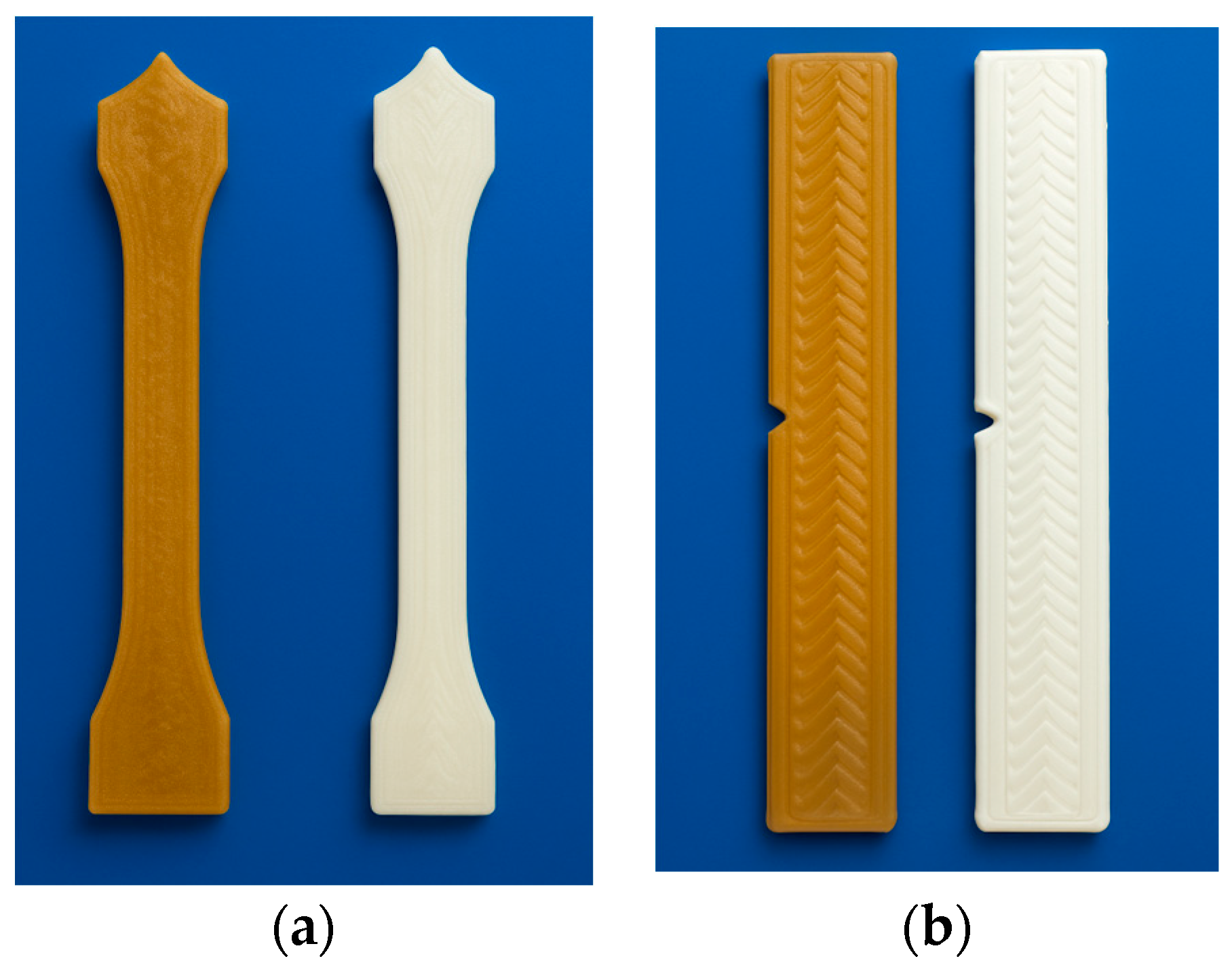
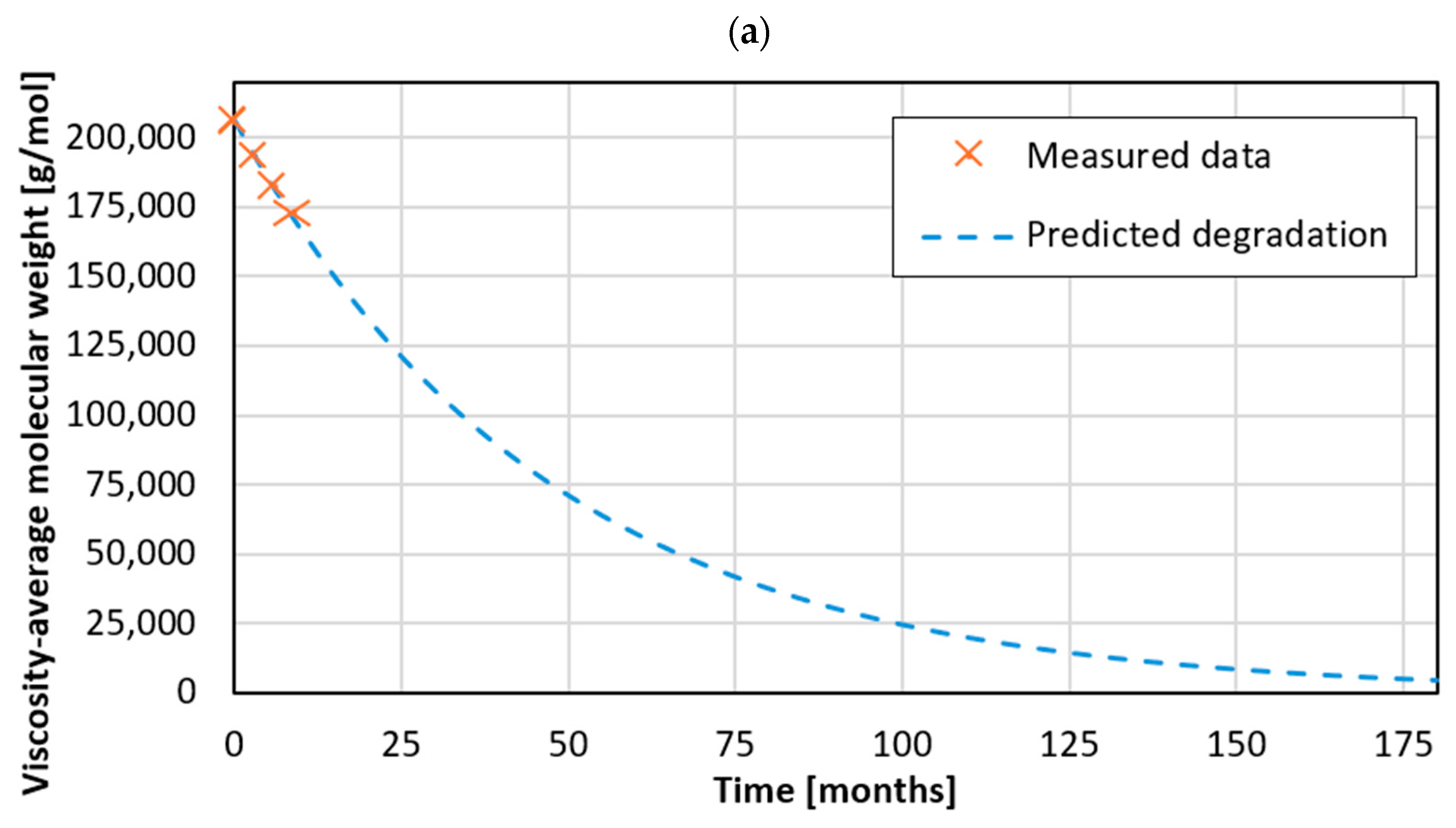

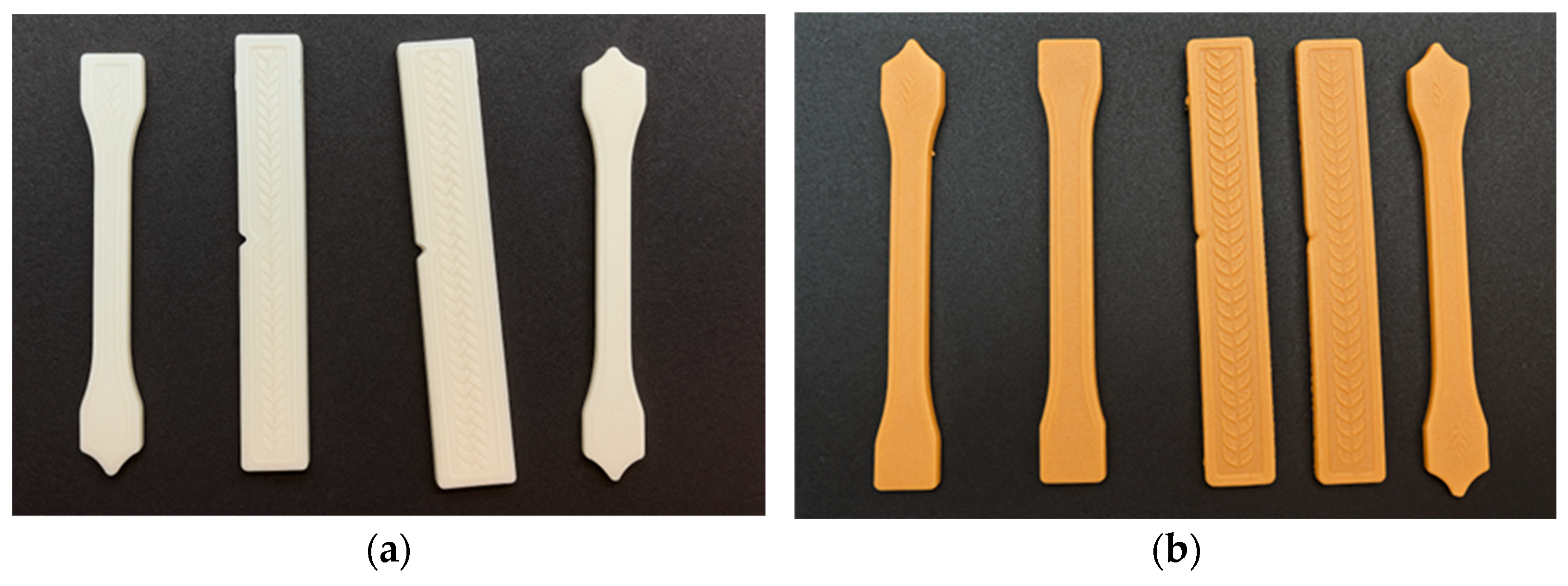
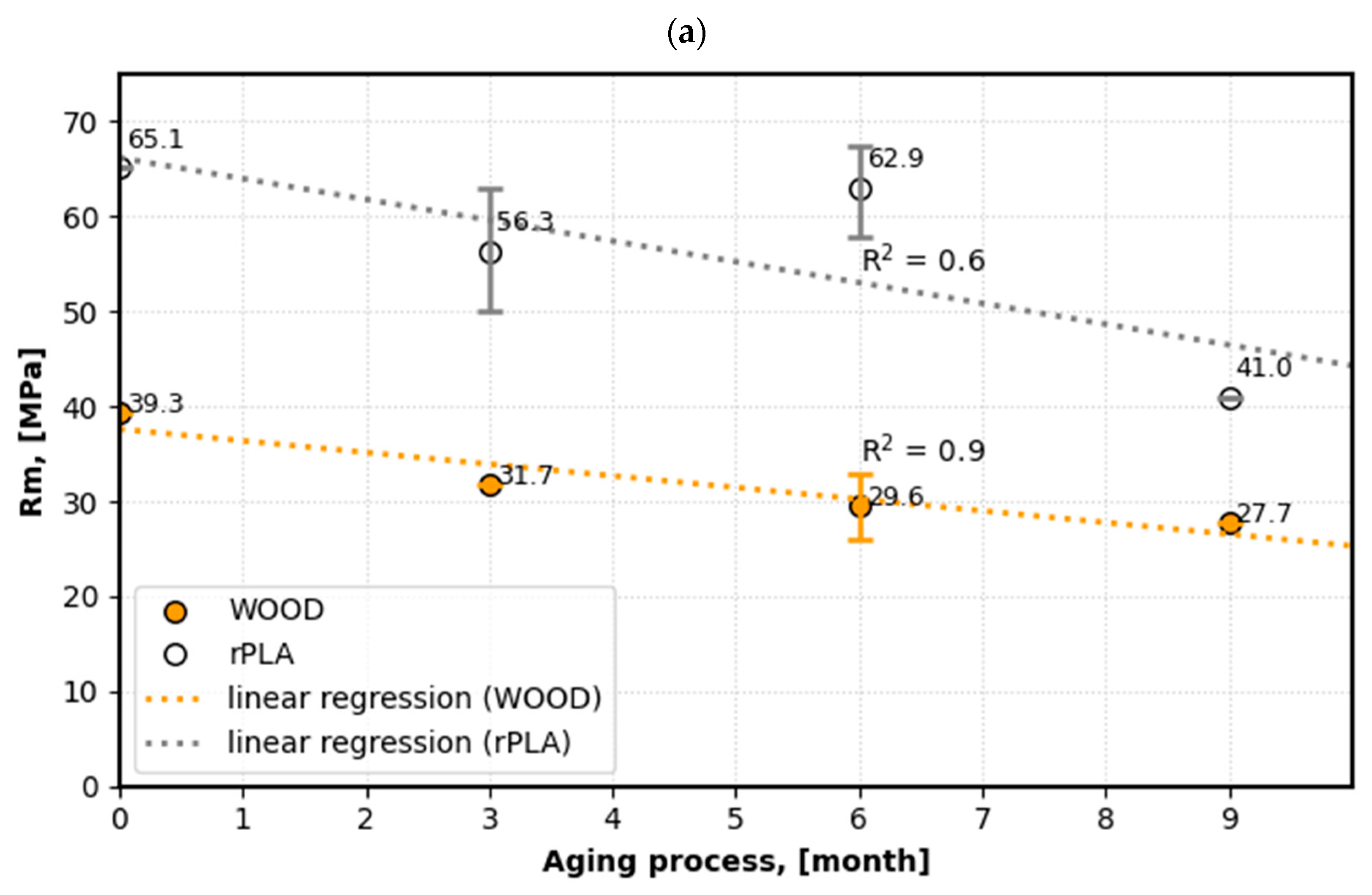

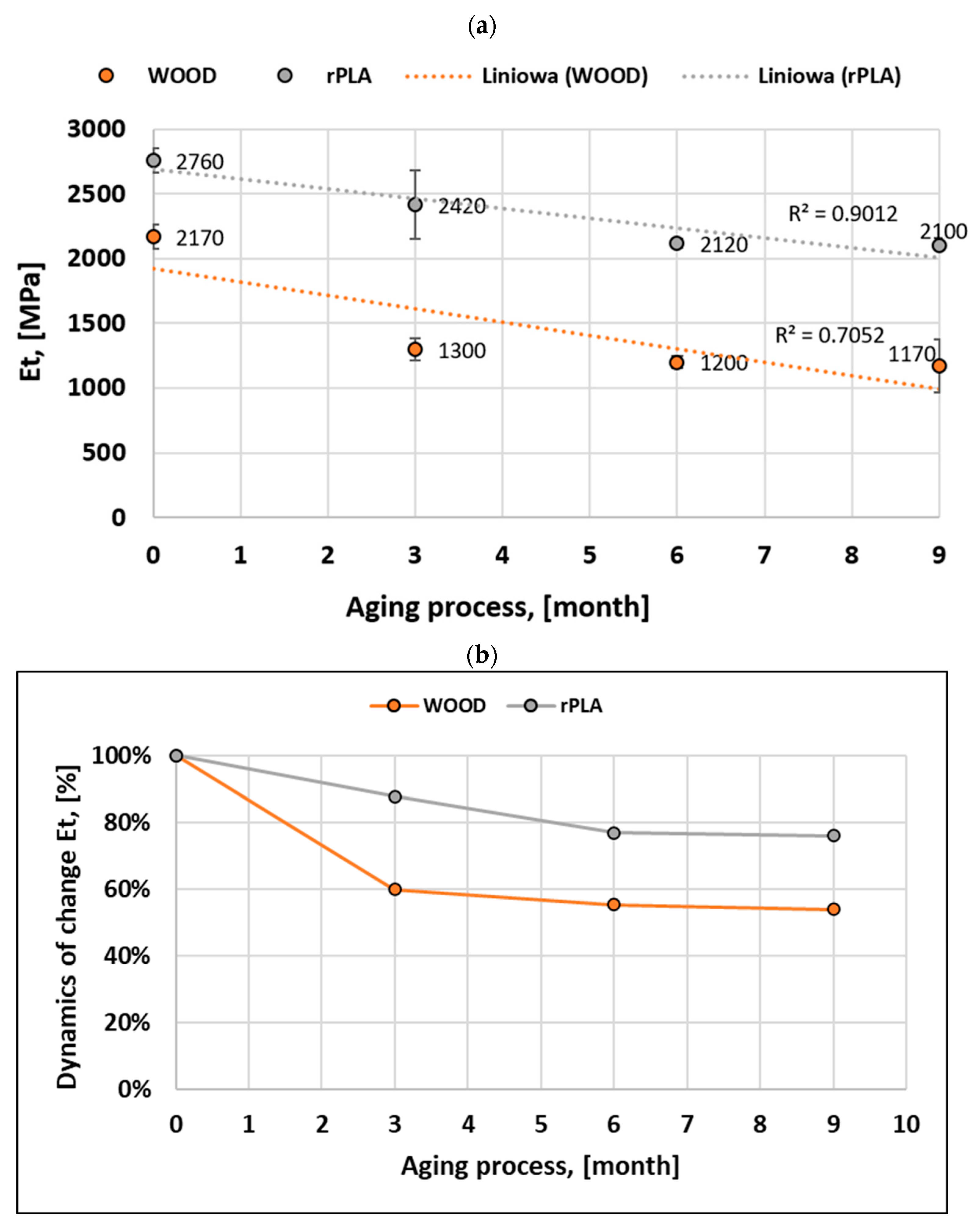
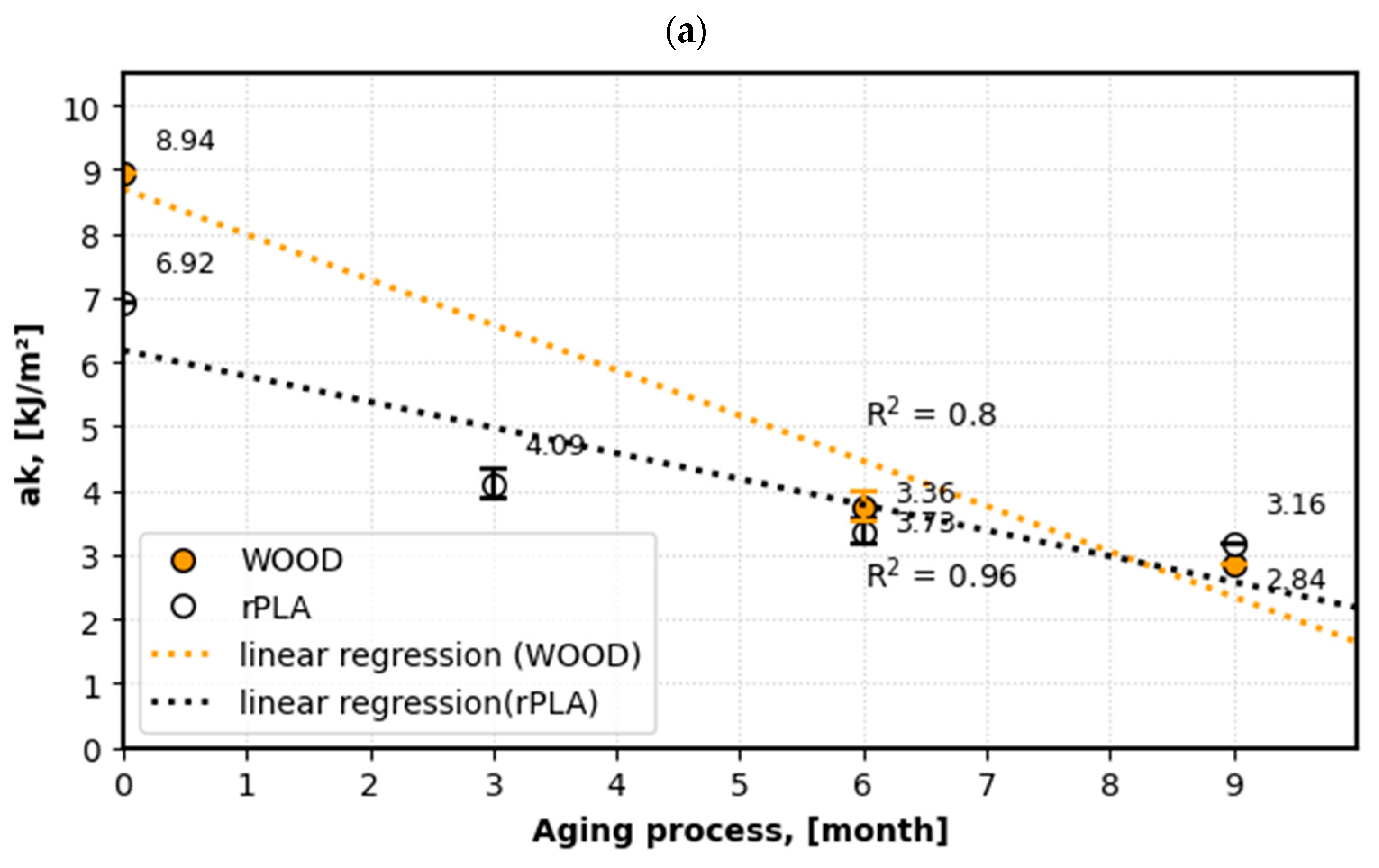
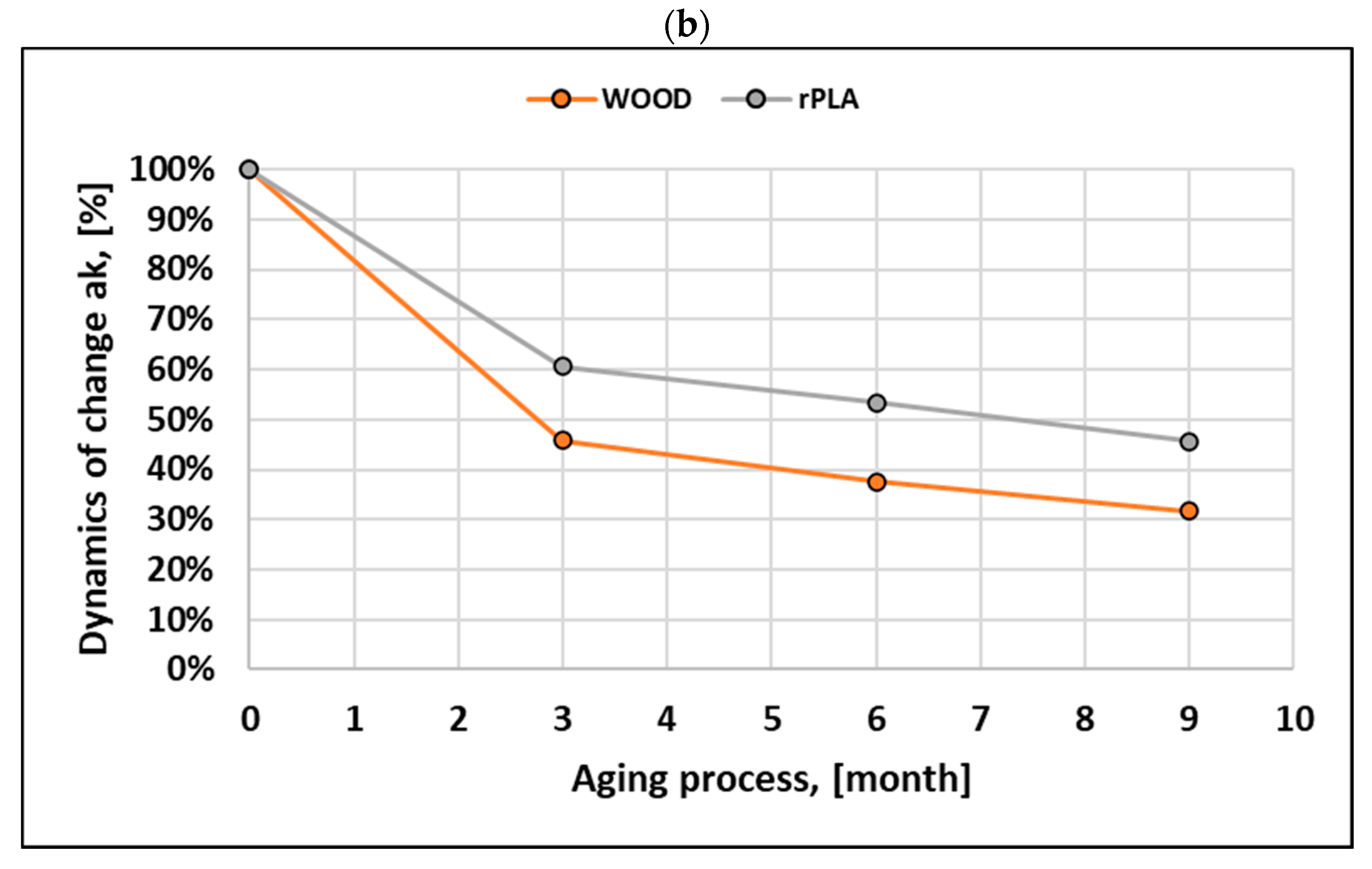
| Properties | Units | Type of Material | Standard | |
|---|---|---|---|---|
| rPLA | WPC (PLA + MD) | |||
| Density, ρ | g cm−3 | 1.2–1.3 | 1.19 | ISO 1183 [31] |
| Tensile strength, Rm | MPa | 53.5 | 53 | ISO 527 [32] |
| Elongation at break, ε | % | 5.5 | ND | ISO 527 [32] |
| Elastic modulus, Et | MPa | 3420 | 3500 | ISO 527 [32] |
| Charpy impact strength, ak | kJ m−2 | 7.5 | 16 | ISO 179 [33] |
| Filament diameter | mm | 1.75 ± 0.05 | - | |
| Parameters | Units | Value |
|---|---|---|
| Initial printing temperature | °C | 230 |
| Printing temperature | °C | 200 |
| Temperature plate | °C | 60 |
| Print speed | mm s−1 | 50 |
| Infill speed | mm s−1 | 50 |
| Wall speed | mm s−1 | 25 |
| Diameter nozzle | mm | 1.75 |
Disclaimer/Publisher’s Note: The statements, opinions and data contained in all publications are solely those of the individual author(s) and contributor(s) and not of MDPI and/or the editor(s). MDPI and/or the editor(s) disclaim responsibility for any injury to people or property resulting from any ideas, methods, instructions or products referred to in the content. |
© 2025 by the authors. Licensee MDPI, Basel, Switzerland. This article is an open access article distributed under the terms and conditions of the Creative Commons Attribution (CC BY) license (https://creativecommons.org/licenses/by/4.0/).
Share and Cite
Michalska-Pożoga, I.; Bryll, K.; Patyk, R.; Szczepanek, M. The Impact of Aggressive Conditions on the Mechanical and Rheological Properties of Components Produced Using Additive Manufacturing. Materials 2025, 18, 4917. https://doi.org/10.3390/ma18214917
Michalska-Pożoga I, Bryll K, Patyk R, Szczepanek M. The Impact of Aggressive Conditions on the Mechanical and Rheological Properties of Components Produced Using Additive Manufacturing. Materials. 2025; 18(21):4917. https://doi.org/10.3390/ma18214917
Chicago/Turabian StyleMichalska-Pożoga, Iwona, Katarzyna Bryll, Radosław Patyk, and Marcin Szczepanek. 2025. "The Impact of Aggressive Conditions on the Mechanical and Rheological Properties of Components Produced Using Additive Manufacturing" Materials 18, no. 21: 4917. https://doi.org/10.3390/ma18214917
APA StyleMichalska-Pożoga, I., Bryll, K., Patyk, R., & Szczepanek, M. (2025). The Impact of Aggressive Conditions on the Mechanical and Rheological Properties of Components Produced Using Additive Manufacturing. Materials, 18(21), 4917. https://doi.org/10.3390/ma18214917









